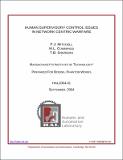Human Supervisory Control Issues in Network Centric Warfare
Author(s)
Cummings, M. L.; Mitchell, P. J.; Sheridan, T. B.
DownloadHAL2004-01.pdf (398.4Kb)
Other Contributors
Massachusetts Institute of Technology. Dept. of Aeronautics and Astronautics. Humans and Automation Laboratory
Metadata
Show full item recordAbstract
Network centric warfare (NCW) is a concept of operations that seeks to increase combat power
by linking battlespace entities to effectively leverage information superiority. A network centric force
must be supported by sophisticated automated systems, so human-computer interactions are an
important aspect of overall performance. These interactions are examples of human supervisory
control (HSC), in which a human operator intermittently interacts with a computer, receiving
feedback from and providing commands to a controlled process or task environment, which is
connected to that computer. The Department of Defense (DoD) has recognized that a lack of
understanding of HSC issues relevant to NCW is a significant barrier limiting NCW’s potential
benefits. This report identifies eight central HSC issues that could significantly impact operator
performance in NCW: Appropriate levels of automation, information overload, adaptive automation,
distributed decision-making through team coordination, complexity measures, decision biases,
attention allocation, and supervisory monitoring of operators.
The adoption of NCW principles is often misunderstood as requiring increased levels of automation,
which makes this a particularly acute problem as NCW is implemented. For the average operator,
implementation of NCW will exponentially add to the number of available information sources as
well as the volume of information flow. Without measures to mediate this volume, information overload
will occur much more often than in the past, as it will be far easier for operators to obtain or be given
more information than they can adequately handle. One way to alleviate this problem is through
adaptive automation, which has been shown in certain cases to lower workload. There will also be a
corresponding increase in information complexity, quantified by complexity measures, which can cause a
loss of situation awareness or an unmanageable increase in mental workload. It is therefore essential
that the interfaces with which NCW operators interact help to reduce and manage this increased level
of data complexity.
A more fundamental issue associated with the increase in the number of available information
sources, volume of information, and operational tempo under NCW are operator attention allocation
strategies. NCW hinges on successful information sharing, so knowledge of the relationship between
perceived and actual high priority tasks and associated time management strategies, as well as the
impact of task disruptions is critical. As a result of NCW information sharing, command and control
(C2) structures will change significantly. Traditional methods where commands are passed down
from higher levels in a command hierarchy will, at least, be partially replaced by distributed decisionmaking
and low-level team coordination. Therefore, understanding how to make effective, timepressured
decisions within these organizational structures takes on greater importance in NCW.
These redefined C2 structures will drive an increase in information-sharing tempo and rapid
decision-making. Under these time pressures, the use of heuristics and other naturalistic decisionmaking
methods may be subject to undesirable decision biases, both for individuals and groups. Lastly,
how automated technology can be leveraged in order to observe and diagnose HSC issues during
supervisory monitoring of operators is another significant area of concern since NCW will contain
embedded HSC systems.
Date issued
2004Publisher
MIT Humans and Automation Laboratory
Series/Report no.
HAL Reports;HAL2004-01